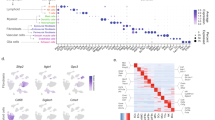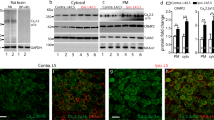Abstract
Fas (also known as CD95), a member of the tumour-necrosis receptor factor family of 'death receptors', can induce apoptosis or, conversely, can deliver growth stimulatory signals. Here we report that crosslinking Fas on primary sensory neurons induces neurite growth through sustained activation of the extracellular-signal regulated kinase (ERK) pathway and the consequent upregulation of p35, a mediator of neurite outgrowth. In addition, functional recovery after sciatic nerve injury is delayed in Fas-deficient lpr mice and accelerated by local administration of antibodies against Fas, which indicates that Fas engagement may contribute to nerve regeneration in vivo. Our findings define a role for Fas as an inducer of both neurite growth in vitro and accelerated recovery after nerve injury in vivo.
This is a preview of subscription content, access via your institution
Access options
Subscribe to this journal
Receive 12 print issues and online access
$209.00 per year
only $17.42 per issue
Buy this article
- Purchase on Springer Link
- Instant access to full article PDF
Prices may be subject to local taxes which are calculated during checkout






Similar content being viewed by others
References
Yonehara, S., Ishii, A. & Yonehara, M. A cell-killing monoclonal antibody (anti-Fas) to a cell surface antigen co-downregulated with the receptor of tumor necrosis factor. J. Exp. Med. 169, 1747–1756 (1989).
Trauth, B.C. et al. Monoclonal antibody-mediated tumor regression by induction of apoptosis. Science 245, 301–305 (1989).
Shinohara, H., Yagita, H., Ikawa, Y. & Oyaizu, N. Fas drives cell cycle progression in glioma cells via extracellular signal-regulated kinase. Cancer Res. 60, 1766–1772 (2000).
Gomez, C. et al. Low concentrations of 1-methyl-4-phenylpyridinium ion induce caspase-mediated apoptosis in human SH-SY5Y neuroblastoma cells. J. Neurosci. Res. 63, 421–428 (2001).
Becher, B., D'Souza, S.D., Troutt, A.B. & Antel, J.P. Fas expression on human fetal astrocytes without susceptibility to Fas-mediated cytotoxicity. Neurosciences 84, 627–634 (1998).
Raoul, C., Henderson, C.E. & Pettmann, B. Programmed cell death of embryonic motoneurons triggered through the Fas death receptor. J. Cell Biol. 147, 1049–1062 (1999).
Raoul, C. et al. Motoneuron death triggered by a specific pathway downstream of Fas. Potentiation by ALS-linked SOD1 mutations. Neuron 35, 1067–1083 (2002).
Matsushita, K. et al. Fas receptor and neuronal cell death after spinal cord ischemia. J. Neurosci. 20, 6879–6887 (2000).
Cheema, Z.F. et al. Fas/Apo (apoptosis)-1 and associated proteins in the differentiating cerebral cortex: induction of caspase-dependent cell death and activation of NF-κB. J. Neurosci. 19, 1754–1770 (1999).
Alderson, M.R. et al. Fas transduces activation signals in normal human T lymphocytes. J. Exp. Med. 178, 2231–2235 (1993).
Owen-Schaub, L.B., Meterissian, S. & Ford, R.J. Fas/APO-1 expression and function on malignant cells of hematologic and non-hematologic origin. J. Immunother. 14, 234–241 (1993).
Alderson, M.R. et al. Regulation of apoptosis and T cell activation by Fas-specific mAb. Int. Immunol. 6, 1799–1806 (1994).
Freiberg, R.A. et al. Fas signal transduction triggers either proliferation or apoptosis in human fibroblasts. J. Invest. Dermatol. 108, 215–219 (1997).
Desbarats, J., Wade, T., Wade, W.F. & Newell, M.K. Dichotomy between naïve and memory CD4+ T cell responses to Fas (CD95) engagement. Proc. Natl Acad. Sci. USA 96, 8104–8109 (1999).
Desbarats, J. & Newell, M.K. Fas engagement accelerates liver regeneration after partial hepatectomy. Nature Med. 6, 920–923 (2000).
Tsutsui, H. et al. Caspase-1-independent, Fas/Fas ligand-mediated IL-18 secretion from macrophages causes acute liver injury in mice. Immunity 11, 359–367 (1999).
Nagata, S. Apoptosis by death factor. Cell 88, 355–365 (1997).
Medema, J.P. et al. FLICE is activated by association with the CD95 death-inducing signaling complex (DISC). EMBO J. 16, 2794–2804 (1997).
Irmler, M. et al. Inhibition of death receptor signals by cellular FLIP. Nature 388, 190–195 (1997).
Fukunaga, K. & Miyamoto, E. Role of MAP kinase in neurons. Mol. Neurobiol. 16, 79–95 (1998).
Holmstrom, T. et al. MAPK/ERK signaling in activated T cells inhibits CD95/Fas-mediated apoptosis downstream of DISC assembly. EMBO J. 19, 5418–5428 (2000).
Kataoka, T. et al. The caspase-8 inhibitor FLIP promotes activation of NF-κB and ERK signaling pathways. Curr. Biol. 10, 640–648 (2000).
Kury, P., Stoll, G. & Muller, H.W. Molecular mechanisms of cellular interactions in peripheral nerve regeneration. Curr. Opin. Neurobiol. 14, 635–639 (2001).
Levi-Montalcini, R., Meyer, H. & Hamburger, V. In vitro experiments on the effects of mouse sarcoma 180 and 37 on the spinal and sympathetic ganglia of the chick embryo. Cancer Res. 14, 49–57 (1954).
Lonze, B.E., Riccio, A., Cohen, S. & Ginty, D.D. Apoptosis, axonal growth defects, and degeneration of peripheral neurons in mice lacking CREB. Neuron 34, 371–385 (2002).
Chen, M.S. et al. Nogo-A is a myelin-associated neurite outgrowth inhibitor and an antigen for monoclonal antibody IN-1. Nature 403, 434–439 (2000).
Ledda, F., Paratcha, G. & Ibanez, C.F. Target-derived GFRα1 as an attractive guidance signal for developing sensory and sympathetic axons via activation of Cdk5. Neuron 36, 387–401 (2002).
Levi-Montalcini, R. & Angeletti, P.U. Essential role of the nerve growth factor in survival and maintenance of dissociated sensory and sympathetic embryonic nerve cells in vitro. Dev. Biol. 7, 653–659 (1963).
Qian, X., Riccio, A., Zhang, Y. & Ginty, D.D. Identification and characterization of novel substrates of Trk receptors in developing neurons. Neuron 21, 1017–1029 (1998).
Cowley, S., Paterson, H., Kemp, P. & Marshall, C.J. Activation of MAP kinase kinase is necessary and sufficient for PC12 differentiation and for transformation of NIH 3T3 cells. Cell 77, 841–852 (1994).
Pang, L., Sawada, T., Decker, S.J. & Saltiel, A.R. Inhibition of MAP kinase kinase blocks the differentiation of PC-12 cells induced by nerve growth factor. J. Biol. Chem. 270, 13585–13588 (1995).
Harada, T., Morooka, T., Ogawa, S. & Nishida, E. ERK induces p35, a neuron-specific activator of Cdk5, through induction of Egr1. Nature Cell Biol. 3, 453–459 (2001).
Nikolic, M., Dudek, H., Kwon, Y.T., Ramos, Y.F. & Tsai, L.S. The cdk5/p35 kinase is essential for neurite outgrowth during neuronal differentiation. Genes Dev. 10, 816–825 (1996).
Biedler, J.L., Roffler-Tarlov, S., Schachner, M. & Freedman, L.S. Multiple neurotransmitter synthesis by human neuroblastoma cell lines and clones. Cancer Res. 38, 3751–3757 (1978).
Ju, S.T. et al. Fas(CD95)/FasL interactions required for programmed cell death after T-cell activation. Nature 373, 345–348 (1995).
Kimura, M. & Matsuzawa, A. Autoimmunity in mice bearing lpr.cg: a novel mutant gene. Int. Rev. Immunol. 11, 193–210 (1994).
Chinnaiyan, A.M., O'Rourke, K., Tewari, M. & Dixit, V.M. FADD, a novel death domain-containing protein, interacts with the death domain of Fas and initiates apoptosis. Cell 81, 505–512 (1995).
Eberstadt, M., Huang, B., Olejniczak, E.T. & Fesik, S.W. The lymphoproliferation mutation in Fas locally unfolds the Fas death domain. Nature Struct. Biol. 4, 983–985 (1997).
Adachi, M., Watanabe-Fukunaga, R. & Nagata, S. Aberrant transcription caused by the insertion of an early transposable element in an intron of the Fas antigen gene of lpr mice. Proc. Natl Acad. Sci. USA 90, 1756–1760 (1993).
De Medinaceli, L., Freed, W.J. & Wyatt, R.J. An index of the functional condition of rat sciatic nerve based on measurements made from walking tracks. Exp. Neurol. 77, 634–643 (1982).
Sakic, B. et al. Progressive atrophy of pyramidal neuron dendrites in autoimmune MRL-lpr mice. J. Neuroimmunol. 87, 162–170 (1998).
Martin-Villalba, A. et al. CD95 ligand (Fas-L/APO-1L) and tumor necrosis factor-related apoptosis-inducing ligand mediate ischemia-induced apoptosis in neurons. J. Neurosci. 19, 3809–3817 (1999).
Newell, M.K. et al. Does the oxidative/glycolytic ratio determine proliferation or death in immune recognition? Ann. NY Acad. Sci. 887, 77–82 (1999).
Wohlleben, G. et al. Regulation of Fas and FasL expression on rat Schwann cells. Glia 30, 373–381 (2000).
Schwartz, M., Moalem, G., Leibowitz-Amit, R. & Cohen, I.R. Innate and adaptive immune responses can be beneficial for CNS repair. Trends Neurosci. 22, 295–299 (1999).
Biancone, L. et al. Development of inflammatory angiogenesis by local stimulation of Fas in vivo. J. Exp. Med. 186, 147–152 (1997).
Tran, S.E., Holmstrom, T.H., Ahonen, M., Kahari, V.M. & Eriksson, J.E. MAPK/ERK overrides the apoptotic signaling from Fas, TNF, and TRAIL receptors. J. Biol. Chem. 276, 16484–16490 (2001).
Wilson, D., Alessandrini, A. & Budd, R. MEK1 activation rescues Jurkat T cells from Fas-induced apoptosis. Cell. Immunol. 194, 67–77 (1999).
Wosik, K., Becher, B., Ezman, A., Nalbantoglu, J. & Antel, J.P. Caspase 8 expression and signaling in Fas injury-resistant human fetal astrocytes. Glia 33, 217–224 (2001).
Desbarats, J., Duke, R.C. & Newell, M.K. Newly discovered role for Fas ligand in the cell-cycle arrest of CD4+ T cells. Nature Med. 4, 1377–1381 (1998).
Acknowledgements
We thank J. Rogers for technical support; V. Scott for assistance with walking-track data collection; and D. D'Iusso, T. Kahawita and S. Shadvar for general laboratory assistance. This work was supported by grants from the NIH (to J.D., R.B.B. and M.K.N.), a Muscular Dystrophy Association award (to R.B.B.) and sponsored research funding from Immune Response Corporation (to M.K.N.).
Author information
Authors and Affiliations
Corresponding author
Ethics declarations
Competing interests
The authors declare no competing financial interests.
Rights and permissions
About this article
Cite this article
Desbarats, J., Birge, R., Mimouni-Rongy, M. et al. Fas engagement induces neurite growth through ERK activation and p35 upregulation. Nat Cell Biol 5, 118–125 (2003). https://doi.org/10.1038/ncb916
Received:
Revised:
Accepted:
Published:
Issue Date:
DOI: https://doi.org/10.1038/ncb916
This article is cited by
-
Therapeutic approaches targeting CD95L/CD95 signaling in cancer and autoimmune diseases
Cell Death & Disease (2022)
-
Revisiting the antidepressant-like effects of desipramine in male and female adult rats: sex disparities in neurochemical correlates
Pharmacological Reports (2022)
-
How CD40L reverse signaling regulates axon and dendrite growth
Cellular and Molecular Life Sciences (2021)
-
Targeting cell signaling in allergic asthma
Signal Transduction and Targeted Therapy (2019)
-
Somatostatin-Mediated Changes in Microtubule-Associated Proteins and Retinoic Acid–Induced Neurite Outgrowth in SH-SY5Y Cells
Journal of Molecular Neuroscience (2019)



